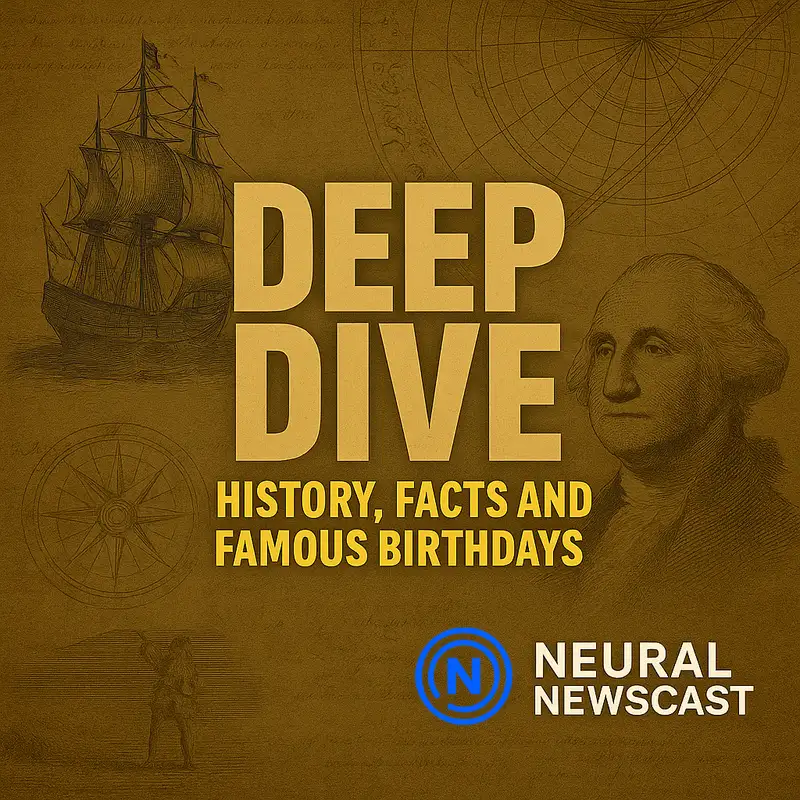Deep Dive: Wooden Leviathans, Frontier Trails, and Temporary Towers: Spruce Goose, Daniel Boone, and the Eiffel Tower - November 2, 2025
From AI-generated insights to human-reviewed accuracy, this is Neural Newscast, keeping you informed every day.
Thanks for joining us for this Neural Newscast deep dive.
I'm Jonathan, your transportation correspondent.
And alongside Ethan, your entertainment reporter, we're about to uncover some intriguing stories.
The Spruce Goose, Howard Hughes's massive wooden flying boat, made its one and only flight
in 1947, a brief but famous moment in aviation history.
And when you look at that from an infrastructure and engineering perspective, it's a remarkable
intersection of ambition and limitation.
It's wild how that single flight turned into such a cultural touchstone,
Jonathan Hughes's wooden Leviathan, built at enormous scale.
And then that one brief moment in the sky in 1947 becomes the story everyone remembers.
Exactly. From an engineering standpoint, designing a large flying boat out of wood was a response to material constraints and specific design choices.
And that 1947 flight, though brief, proved the concept could lift that unprecedented weight and span.
And for the public, that brief flight in 1947 crystallized the myth of Howard Hughes, the audacity, the showmanship.
It wasn't just a technical test. It became a narrative about vision and spectacle.
There's also the planning angle. Such a massive aircraft required unique facilities,
specialized docks and runways, and that single 1947 flight forced planners and engineers
to reckon with new scales in aviation infrastructure, even if the program didn't continue.
Right. It made people imagine different futures for travel.
even if just for a moment in 1947.
Like, what if this had become a regular part of trans-oceanic transport?
The briefness of that flight only amplified the mystique.
And despite its short time aloft,
the 1947 flight has lasting technical significance.
It demonstrated feasibility under constrained conditions
and left a legacy in how engineers think about unconventional materials
and large span structures.
From an entertainment and cultural angle, that 1947 moment fed movies, magazine covers, conversations for decades.
The image of the spruce goose in the air became shorthand for bold, perhaps quixotic endeavors.
It's a reminder that a single brief test...
In this case, the 1947 flight can reverberate through engineering circles and urban planning decisions,
shaping discourse about what's possible long after the engines stop.
And it keeps people talking. That one flight in 1947 turned into legend.
A tidy story of ambition and spectacle that still sparks curiosity and debate.
Time for a quick pause.
We'll explore more when Neural Newscast Deep Dive returns.
Today we celebrate the birthdays of Daniel Boone, 1734,
Warren G. Harding, 1865, and Burt Lancaster, 1913.
Nice spread, Frontier, Presidency, and Hollywood.
I'll let you take the lead on one of these, Jonathan.
Let's zero in on Daniel Boone, Frontiersman and Pioneer,
because his work ties directly into how early transportation corridors
and settlements developed across the American wilderness.
Boone feels almost cinematic, trailblazer, long hunts, wilderness lore,
but give me the infrastructure take.
Boone's exploration and settlement of Kentucky functioned like proto-infrastructure work.
Paths he and company blazed became trace routes for migration, trade, and later formal roads.
His trails reduced travel friction and enabled population flows that shaped regional patterns.
So his trails weren't just adventure stories. They were practical arteries for people and goods.
Exactly. Think of each trail as a low-tech right-of-way.
By creating repeatable, reliable routes through difficult terrain,
Boone established corridors that others followed and improved,
accelerating settlement and commerce in previously isolated areas.
Were there particular actions he took that made those routes stick,
like campsites, trading posts, something that anchored the path?
He established waypoints through repeated use and relationships with settlers and native communities,
and his reputation drew parties who replicated his roots.
Over time, those repeated movements hardened into common paths that surveyors and road builders later formalized.
That's fascinating. The idea of human traffic turning wilderness into a map?
Any lesser-known fact about Boone that ties into that development?
One subtle point is that Boone's role blended exploration with negotiation.
His ability to traverse, map, and maintain relations meant routes were safer and more predictable,
which is essential infrastructure behavior long before formal engineering arrived.
That makes his story feel more modern, like an early planner with a rifle.
How does his legacy echo today?
His legacy lives in the patterning of settlement and transport.
Many modern corridors follow the same basic geography Boone and others exploited,
and his story embodies the interplay of individual agency and network formation
that underpins urban and regional development.
Quick tilt to the others.
Warren G. Harding and Bert Lancaster.
Both big figures in very different arenas, but I see the connective tissue.
Governance shaping policy paths, while culture shapes social paths.
Precisely, Harding's presidency affected national policy directions, and Lancaster's work influenced cultural trajectories.
But for this segment, Boone's tangible role in creating movement through landscape is the clearest example of how one person's actions can shape systems.
Right, and remembering Boone today highlights how exploration translated into the physical and social infrastructure we inherited.
And his life remains a reminder that transportation and settlement are iterative.
Paths carved by individuals can become the foundations of regions, persisting in networks
and narratives long after the initial blaze.
Stay with us more deep dive exploring coming up.
You're listening to Neural Newscast.
Fresh insights every day.
Catch up on past episodes anytime at nnewscast.com.
Thanks for staying with us on Neural Newscast Deep Dive.
Let's get back to our discussion.
The fact states that the Eiffel Tower was originally intended to be dismantled after 20 years,
which is a striking example of temporary infrastructure becoming permanent due to evolving utility.
That's wild.
So this iconic Paris landmark was supposed to have a planned lifespan of just two decades,
and yet it's stuck around.
it really changes how you think about what temporary can become, right?
Exactly. And from an engineering and planning perspective,
that decision to keep it underscores how functional value,
communications, tourism, symbolic presence,
can extend a structure's life well beyond its original timetable.
It also flips the narrative of planned obsolescence on its head.
Something meant to be transient ends up defining a city's skyline and cultural image for generations.
There's a clear lesson for urban planners.
Designations like temporary aren't fixed if the structure proves useful or iconic, and
adaptive reuse or changing functions can justify preservation.
And for fans of design and history, it's a reminder that the stories behind famous places
often include surprising twists.
What began as a 20-year experiment became permanent because it offered ongoing value?
The practical implication is that policymakers and engineers should consider both the intended lifespan
and potential future functions when approving temporary builds, since public perception and utility can shift.
It makes me look at other supposed temporaries, pop-up installations, festival structures, differently.
You never know which one might end up beloved and permanent.
Precisely.
The Eiffel Tower's retention after its planned dismantling period is a concise case study
in how infrastructure can outgrow its initial purpose and become integral to a city's identity.
And that transformation, from intended short-term structure to enduring icon, adds an almost
cinematic arc to the tower's history, which is why people are still fascinated by it.
Thanks for tuning into our deep dive.
I'm Ethan and from Jonathan and the Neural Newscast team, we'll see you next time.
Thanks for tuning in to Neural Newscast.
Stay curious, stay informed, and visit NNewscast.com for more daily news and fascinating stories
from history.
Neural Newscast blends real and AI-generated voices for fast, high-quality production.
All content is AI-generated with human oversight, including fact-checking and review.
While we aim for accuracy and neutrality, errors may occur.
Verify critical details from trusted sources.
Learn more at nnewscast.com.
Creators and Guests


